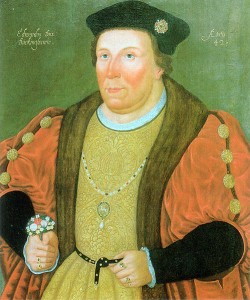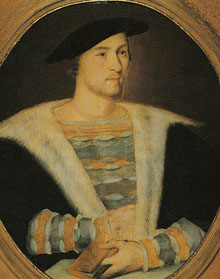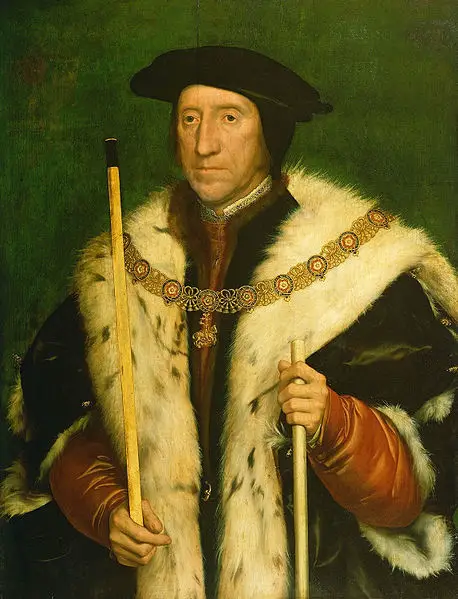Edward Stafford was born on the 3rd February 1478, at Brecon Castle in Wales to Henry Stafford, 2nd Duke of Buckingham and Lady Katherine Woodville, younger sister of Queen Elizabeth Woodville. Stafford had a long and royal lineage dating back to Thomas of Woodstock, the fifth son of King Edward III. In his adulthood, it was claimed by some that Stafford had a better claim to the English throne, through both his father and mother’s family than Henry VIII did. Such a claim would later come to cost Stafford his life.
The Stafford’s had a long and proud association with the Lancastrians. Stafford’s great-great-grandfather was killed at the battle of Shrewsbury in 1403, fighting for King Henry IV. His great-grandfather, the 1st Duke of Buckingham died fighting for the Lancastrian side at Northampton in 1460. His father Henry Stafford, 2nd Duke of Buckingham, had also been a staunch Lancastrian and supporter of King Richard III. However shortly after Richard III came to the throne, Henry Stafford rebelled against the new King. It is unclear as to why Henry chose to rebel against a man he had previously supported. Some have suggested it was because he sought the throne for himself, others proposing that Henry was disgusted by what Richard III was alleged to have done to his nephews, the Princes in the Tower. Whatever the true reason the rebellion failed, and he was executed at Salisbury on the 2nd November 1483. Edward Stafford was only five and a half years of age.
Upon his death, all of Henry Stafford’s lands and property were forfeited to the crown by attainder. When Henry Tudor claimed the English throne in August 1485, he reversed the attainder and little Edward Stafford’s wardship as well as the possession of his lands and property, were granted to Lady Margaret Beaufort, Henry VII’s mother.
Upon King Henry VII’s accession to the throne, Edward’s prospects began to rise. He was created a Knight of the Bath on the 29th October 1485, and ten years later in 1495, he was invested as a Knight of the Garter, the highest order of chivalry in England. The previous year, on the 9th November, Edward was at court when Prince Henry, Henry VII’s second son, was created Duke of York. In September 1497, at just nineteen years of age, he was appointed as captain of the army against the Cornish rebels. Edward was also present when Katherine of Aragon married Arthur Tudor in 1501. On the 9th March 1503, he was appointed High Steward for the day for Archbishop Warham’s enrolment. During the reign of Henry VII, Edward Stafford regained his father’s dukedom and was created 3rd Duke of Buckingham.
In 1500, Edward married Eleanor Percy, the eldest daughter of Henry Percy, 4th Earl of Northumberland. The couple had four children, a son named Henry and three daughters, Elizabeth, Katherine and Mary.
When Henry VII died in 1509 and his son Henry VIII succeeded the throne Edward began to take an even more prominent position at court. He was appointed as Lord High Constable for Henry VIII and Katherine of Aragon’s coronation and also had the high honour of carrying Henry VIII’s crown. In November of the same year, he was sworn in as a member of the Privy Council and attended parliament regularly. In June 1513 he was appointed as the captain of the English army which invaded France, in charge of five hundred men.
In addition to this, Edward Stafford served as Commissioner of the Peace for Staffordshire, Warwickshire, Shropshire, Herefordshire, Gloucestershire, Buckinghamshire, Surrey, Kent, and Somerset. In 1520, he attended Henry VIII at the magnificent Field of Cloth of Gold and also the secret meeting with Charles V at Gravelines in the weeks following.
With royal blood flowing through his veins some soon came to see Edward Stafford as a possible claimant to the English throne. By 1521 Henry VIII and Katherine of Aragon had been married twelve years and only had one living child, a daughter. Some began to whisper that Stafford had a better claim to the throne and that Stafford was speaking words of treason against the King. It has also been suggested that Stafford rested Thomas Wolsey, a low-born man with no royal blood having risen to become the right-hand man of the King. Cardinal Thomas Wolsey soon found out about such whispers and reported to Henry VIII what was being said. The King immediately ordered an investigation.
On the 8th of April 1521, Edward Stafford was ordered to London. He set out for London and was arrested along the way. It is reported that the arrest came as a shock to the Duke and he had no idea under what charges he had been arrested. He was sent to the Tower of London on the 16th April.
On the 12th of May, Gasparo Contarini wrote:
It is reported from England that the King had ordered the arrest of the Duke of Buckingham, the chief personage in that kingdom, together with two other Knights of the Garter. The real cause is not known, but according to report the Duke had plotted to assassinate Cardinal Wolsey. This the English ambassador denies, though he does not know the reason, affirming merely the fact of the arrest, and that the King had surrendered the Duke for trial by the peers of the realm.1
Stafford’s trial began on the 13th May, and he was charged with listening to prophecies about Henry VIII’s death and his own succession to the throne as well as imagining Henry VIII’s death. These accusations came from members of Stafford’s household, who Stafford was not allowed to cross-examine in his own defence. For such offences, Stafford was found guilty and sentenced to death.
It is reported that:
Duke spoke in his defence for an hour, confuting the charges brought against him with great eloquence, in such wise that all were affected, and no one dared pass sentence; so the Duke perceiving their silence and whispering, urged them to speak, assuring them that he knew it was the King's will that he should die, and that he was content to accept the punishment, not for the crime laid to his account, which was utterly false, but for his very great sins.2
Gasparo Contarini continued his correspondence stating that:
The Royal Courts (li eonsegli regj) have condemned the Duke of Buckingham to death. He will be definitively sentenced this morning (13 May) at Westminster, the final sentence having been passed ordering him for decapitation; and he is gone back to the Tower to be executed according to the custom here, and they will do by him as was done by his father and grandfather.3
On the 17th May 1521, Edward Stafford was led to Tower Hill where he was beheaded. Gasparo Contarini summarises the Duke’s death:
This morning the late Duke of Buckingham was taken “in forza de' brazi” from the Tower to the scaffold, at the usual place of execution, with a guard of 500 infantry. He addressed the populace in English. Then on his bended knees he recited the penitential psalms, and with the greatest composure calling the executioner, requested that he would dispatch him quickly, and forgave him; after which he took off his gown, and having had his eyes blindfolded, he laid his neck on the block, and the executioner with a woodman's axe severed his head from his body with three strokes.
The corpse was immediately placed in a coffin and carried to the church of the Austin Friars, accompanied by six friars and all the infantry.
The death of the Duke has grieved the city universally. Many wept for him, as did one-third of the spectators, among whom was I. Our Italians had not the heart to see him die. And thus miserably, but with great courage, did he end his days on the 17th of May.4
Despite Stafford’s fierce defence, proclaiming his innocence, there was little he could do. Ultimately for his royal lineage and talk that he could claim the English throne, Henry VIII needed him gone; the easiest and most effective way to do that was by order of death. Whether Edward Stafford had any serious intention to claim the throne for himself will forever remain unknown.
Sarah Bryson is the author of "Mary Boleyn: In a Nutshell" and "Charles Brandon: The King's Man". She is a researcher, writer and educator who has a Bachelor of Early Childhood Education with Honours and currently works with children with disabilities. Sarah is passionate about Tudor history and has a deep interest in Mary Boleyn, Anne Boleyn, the reign of Henry VIII and the people of his court. Visiting England in 2009 furthered her passion and when she returned home she started a website, queentohistory.com, and Facebook page about Tudor history. Sarah lives in Australia, enjoys reading, writing, Tudor costume enactment and is currently writing a biography of Mary Tudor, sister of Henry VIII.
Notes
- Calendar of State Papers Venice, Vol 3, 209.
- Ibid., 213.
- Ibid., 210.
- Ibid., 213.
Sources
- Calendar of State Papers Relating To English Affairs in the Archives of Venice, Her Majesty's Stationery Office, London, 1871.
- Cannon, J.A (2002) "Buckingham, Edward Stafford, 3rd duke of", The Oxford Companion to British History, viewed 20 January 2017, http://www.encyclopedia.com/people/history/british-and-irish-history-biographies/edward-3d-duke-buckingham-stafford.
- "Duke of Buckingham", Shakespeare and History, viewed 20 January 2017, http://www.shakespeareandhistory.com/duke-of-buckingham-henry-viii.php.
- Jokinen, A, "Edward Stafford, Duke of Buckingham (1478-1521)", Luminarium: The Encylopedia Project, viewed 20 January 2017, http://www.luminarium.org/encyclopedia/edwardstafford.htm.
- Richard III Society – American Branch, "Henry Stafford, Second Duke of Buckingham", viewed 20 January, http://www.r3.org/on-line-library-text-essays/back-to-basics-for-newcomers/henry-stafford-second-duke-of-buckingham/.




Fascinating post – thank you! Have seen Brecon Castle in Wales.